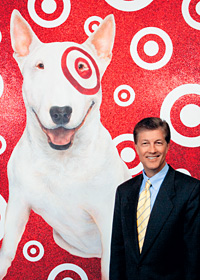| |
 |
| |
Gregg
Steinhafel's commitment to teamwork has allowed him to
help build a collaborative culture at Target. Photo
© Target Corporation |
| |
|
With
teamwork, Gregg Steinhafel '79 hits the bull's-eye at Target
Gregg
has been a generous friend to Kellogg, especially in giving
his time and expertise to speak to students.
By Matt
Golosinski
Teamwork
is more than just a nice idea to Gregg Steinhafel '79.
It's a personal value and foundational to the company for
which he works.
It
has to be, given the market competition confronting him as
president of Target, the fifth-largest retailer by sales in
the U.S. and the nation's second-largest general merchandise
discount retailer.
Ranked
No. 33 in the Fortune 500, Target operates more than 1,500
stores, including SuperTargets that carry a full line of groceries.
Inspiring more than 350,000 team members to communicate effectively
across this enterprise demands the talents that Steinhafel,
52, says his Kellogg School education helped provide.
"Kellogg
was a life-shaping experience for me," he says. "The
school was way out in front as an innovator in the team concept."
That
concept defines the Minneapolis-based company, says Steinhafel,
noting that Target's success is rooted in a cross-functional
approach that helps drive its brand promise: "Expect
More. Pay Less."
"Our
content has to be distinctive, unique and right on track with
specialty stores," he says, adding a tricky qualifier:
"at half the price."
For
that to happen, Target's merchandising, product design and
development, global sourcing, supply chain and marketing teams
must work together seamlessly.
"One
of the things we hear we do well from our vendor community
is take initiatives and move them through our organization
quickly," Steinhafel says. "The only way we implement
so effectively is to work as a team."
For
example, he says Target's "GO" apparel program —
which features limited-edition women's fashion created by
internationally renowned designers — demands cross-functional
talent.
It's
a collaborative effort that requires coordination across many
areas, including teams in merchandising, marketing, design,
communications, presentation, supply chain and stores. "All
of them must be engaged in bringing this concept to life,"
says Steinhafel, also a Target board member.
Knowing
how and when to change its inventory is another team challenge.
It can be tempting to hang onto last year's best-selling product,
instead of moving the market forward. But moving too fast
is also dangerous.
"We
constantly push our teams to move ahead, but not too far ahead,"
says Steinhafel. "You can make as many mistakes by being
too slow as by upgrading too fast and getting into quality
levels and prices where our guests aren't ready to go. But
if we don't bring our guests along and constantly update our
assortments, we become just another retailer."
To
win, Target's leadership engages the power of all its team
members. "We're an organization focused on innovation,"
says Steinhafel, who has been with the company since 1979,
"so we encourage everyone to think about what's next.
Everyone has an obligation to scour the marketplace to discover
the next great idea, whether it's in supply chain, financial
services, merchandising or marketing."
But
Target doesn't jump at just any idea, he says. "We take
a very deliberate approach: We pick fewer, but bigger, initiatives
that are really going to make a difference for our guests
and that are aligned with our 'Expect More. Pay Less.' strategy."
One
such effort was the massive undertaking that began in 1995
to add groceries to select Target stores, transforming them
into SuperTargets. Other "transformational initiatives"
have included Target's commitment to global sourcing and owned
brand development.
While
pursuing these initiatives, Target has remained committed
to the larger community, says Steinhafel. Since it first opened
its doors, Target has given 5 percent of its
income to the communities it serves. Today that equals
more than $3 million every week to support education, the
arts and social services, such as United Way. Target also
encourages its team members to be involved in their communities.
Each year, team members donate hundreds of thousands of hours
to community projects around the world where they live and
work.
"We're
identified with integrity and strong corporate citizenship,"
says Steinhafel. Such values, he adds, are anchored in the
company's long Midwestern history: The first Target store
opened in 1962, but the company traces its origins to 1902,
as Dayton's Dry Goods store.
"We
attract performance-oriented people who understand the values
that we live every day," says the Kellogg alum. "We
have a very healthy, vibrant, aggressive and honest company
— guided by our moral compass."
|



